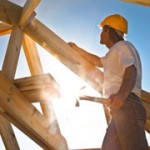Summer Construction: Are You Ready for the Housing Market to Heat Up?

There’s finally good news for the residential housing market: The U.S. Commerce Department recently announced that new residential construction surged in April to its highest level in more than seven years in the United States.
Although homebuilding revenue remains well below its prerecession peak of nearly a decade ago, the housing market appears to be recovering. Growth is likely to continue in the coming months, because summer has historically been a peak season for residential construction. In fact, average construction spending is typically 35% higher in the summer than in the winter, according to the U.S. Census Bureau.
Here’s more on these trends and insight into several products and services that may cost you more (or less) as demand for residential construction heats up.
Warmup Underway
Whether you’re a homebuilder or a homeowner, trends in residential construction are relevant to you. After a harsh winter slowed growth in homebuilding during the first quarter of 2015, housing starts in April jumped 20.2% over the previous month to an annualized rate of 1.14 million — the highest level of new home starts since November 2007 and the highest month-over-month growth since February 1991.
In May, construction was up 16.7% for single-family homes and 27.2% for multifamily projects, such as townhouses and apartment buildings. Growth was strongest in the northeastern and western regions. The South was the only area that showed a decline.
May also marked the month with the highest number of building permits issued since June 2008. So the growth trend in residential construction is expected to continue.
One key reason for the growth in the housing market is the low cost of borrowing. The Fed continues to keep interest rates near historic lows. As of June 4, the average rate on a 30-year fixed-rate mortgage was 3.87%, according to the Freddie Mac Weekly Mortgage Survey. Other reasons for growth in residential construction include a stronger labor market and increased consumer confidence in the economy.
More Demand, Higher Costs
If you’re planning to build or remodel this summer, bear in mind that an increase in demand also may result in higher costs for certain building materials and services. These increases can quickly cause your project to go over its budget, if you’re not mindful of what’s expected to cost more this summer.
This year, The Associated General Contractors (AGC) of America, a trade association, predicts price increases for drywall, concrete and cement. In addition, research firm IBISWorld has identified the following auxiliary products and services as potential candidates for price increases this summer:
- Safety equipment, such as cloth gloves and ear plugs,
- Heavy equipment rental, such as earth-moving machines, wood chippers and concrete mixers, and
- Plumbing and sewer inspection services.
Ways to beat cost increases include buying or negotiating long-term purchase contracts early in the season (before shortages occur) and buying in bulk, especially for smaller items that don’t incur high storage costs or risk pilferage from laborers. When possible, also consider postponing the use of inspectors and rented equipment until September or October to negotiate a lower price off-season.
On the upside, AGC expects some materials costs to decrease this summer, including the costs of lumber, insulation and petroleum-based products (such as asphalt, tar and siding). Lower petroleum prices also translate to lower gas costs to transport goods and operate equipment this summer.
Ways to Avoid Getting Burned as the Market Heats Up
Because it’s a leading indicator of overall economic health, a stronger residential housing market is good news for everyone. Contractors and individuals that plan to build or remodel homes this summer should contact their financial and legal advisers for assistance with budgeting, business planning and negotiating contracts to hedge against price increases and position themselves to add value as the residential market heats up.
More Housing Market TrendsSales of existing homes are currently strong in many parts of the country. As of May, Realtor.com reports that inventory is mounting, prices are currently up 7% compared to 2014 and the median time on the market was only 66 days, compared to 73 days for May 2014. According to Realtor.com, the top 10 hottest real estate markets in May 2015 for residential buyers and sellers are:
Realtor.com selected these markets because they show signs of economic recovery and housing is relatively affordable compared to neighboring areas. Several areas — including Denver and San Francisco — tend to favor sellers due to low inventories of homes for sale. The National Association of Realtors (NAR) also recently reported that pending home sales in April — a forward-looking metric based on signed contracts — reached the highest level in nine years. Regions with the highest growth are the Midwest and Northeast. NAR forecasts total existing-home sales in 2015 to be around 5.24 million, an increase of 6.1% over 2014. The median selling price of existing homes is also expected to increase around 6.7% in 2015. |
© Copyright 2015. All rights reserved.
Brought to you by: McClanathan, Burg & Associates, LLC




